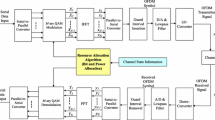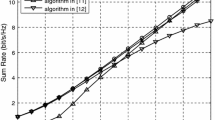Abstract
In this paper we present a computationally efficient, suboptimal integer bit allocation algorithm that maximizes the overall data rate in multiuser orthogonal frequency division multiplexing (OFDM) systems implemented in wireless networks. Assuming the complete knowledge of a channel and allowing a subchannel to be simultaneously shared by multiple users we have solved this data rate maximization problem in two steps. The first step provides subchannel assignment to users considering the users’ requests on quality of service (QoS) expressed as the minimum signal-to-noise ratio (SNR) on each subchannel. The second step provides transmit power and bit allocation to subchannels in order to maximize the overall data rate. To reduce computational complexity of the problem we propose a simple method which assigns subchannels to users and distributes power and bits among them. We have analyzed the performance of our proposed algorithm by simulation in a multiuser frequency selective fading environment for various signal-to-noise ratios and various numbers of users in the system. We have concluded that our algorithm, unlike other similar algorithms, is suitable for OFDM wireless networks, especially when signal-to-noise ratio in the channel is low. Also, the results have shown that the total data rate grows with the number of users in the system.




Similar content being viewed by others
References
Chow, P.S. (1993). Bandwidth optimized digital transmission techniques for spectrally shaped channels with impulsive noise. Ph.D. dissertation, Stanford Univ: Stanford, CA.
Chow, P. S., Cioffi, J. M., & Bingham, J. A. C. (1995). A practical discrete multitone transceiver loading algorithm for data transmission over spectrally shaped channels. IEEE Transactions on Communications, 43, 773–775.
Leke, A., & Cioffi, J. M. (1997). A maximum rate loading algorithm for discrete multitone modulation systems. In Proc. IEEE GLOBECOM’97 (pp. 1514–1518). Phoenix, AZ, Nov. 1997.
Fisher, R. F. H., & Huber J. B. (1996). A new loading algorithm for discrete multitone transmission. In Proc. IEEE GLOBECOM’96 (pp. 724–728). London, U.K., Nov. 1996.
Hughes-Hartogs, D. (1989). Ensemble modem structure for imperfect transmission media. 4 679 227 (Luly 1987), 4 731 816 (March 1998) and 4 833 796 (May 1989).
Wong, C. Y., Cheng, R. S., Letaief, K. B., & Murch, R. D. (1999). Multiuser OFDM with adaptive subchannel, bit and power allocation. IEEE Journal on Selected Areas in Communications, 17, 1747–1758.
Rhee, W., & Cioffi, J. M. (2000). Increase in capacity of multiuser OFDM system using dynamic subchannel allocation. In Proc. 51st IEEE Vehicular Technology Conf., 2 (pp. 1085–1089). Spring.
Jang, J., & Kwang, B. L. (2003). Transmit power adaptation for multiuser OFDM systems. IEEE Journal of Selected Areas in Communications, 21(2), 171–178.
Biglieri, E. (2003). Coding and modulation for a horrible channel. IEEE Communications Magazine, 41, 92–98.
Proc. 2001 Int’I. Symp. Power-Line Commun. and Its Apps. Malmö, Sewden, April 4–6, 2001.
Raphaeli, D., & Bassin, E. (1999). A comparison between OFDM, single carrier, and spread spectrum for high data rate PLC. In Proc. 2001 Int’I. Symp. Power-Line Commun. and Its Apps. Lancaster, UK, Mar. 30–Apr. 1, 1999.
Goldsmith, A. J., & Chua, S.-G. (1997). Variable-rate variable-power MQAM for fading channels. IEEE Transactions on Communications, 45, 1218–1230.
Cover, T. M., & Thomas, J. A. (1991). Elements of information theory. New York: Wiley.
Biglieri, E., Proakis, J., & Shamai, S. (1998). Fading channels: Information theoretic and communications aspects. IEEE Transactions on Information Theory, 44, 2619–2692.
Leke, A., & Cioffi, J. M. (1997). Transmit optimization for time-invariant wireless channels utilizing a discrete multitone approach. In Proc. IEEE ICC’97 (pp. 954–958). Montreal.
Knopp, R.. & Humblet, P. A. (1995). Information capacity and power control in single-cell multiuser communications. In Proc. IEEE Int. Conf. Communications 1995 (ICC’95) (pp. 331–335). Seattle, WA.
Author information
Authors and Affiliations
Corresponding author
Appendix
Appendix
1.1 Proof of the Theorem 1
Following the discussion in Sect. 3 and in order to maximize data rate, we have solved the subchannel assignment problem using our theorem (Theorem 1) which states that k users can share the same subchannel m with required SNR value ╬│j,m only if
Proof
Signal to noise ratio (SNR) for the i-th user on the m-th subchannel can be written as
By introducing the userΓÇÖs request on SNR, the problem is then formulated as
One of the optimal power vectors is obtained if
This leads to the matrix formulation \({\mathbf{DS}}=N_{0}B_{m}{\mathbf{I}}\) where
\({\mathbf{S}}= [s_{1,m},s_{2,m},{\ldots},s_{M,m}]^{T}\) is the optimal power vector, and I is the unity matrix. After doing two elementary matrix operations (subtracting the first row from the next one, and starting from the second row, multiplying each row with \({\omega _{j,m} }/{({\omega _{j,m} +\frac{1}{\gamma _{j,m} }})}\) and adding it to the first row) the matrix form is reduced. Diagonal elements and elements in the first column are non-zero. The equation with parameter s1,m is
Power s 1,m must be positive which yields the following condition
and completes the proof of Theorem 1. Γûí
Rights and permissions
About this article
Cite this article
Ilić, Ž., Bažant, A. & Modlic, B. An efficient data rate maximization algorithm for OFDM based wireless networks. Wireless Netw 16, 17–25 (2010). https://doi.org/10.1007/s11276-008-0111-8
Published:
Issue Date:
DOI: https://doi.org/10.1007/s11276-008-0111-8




